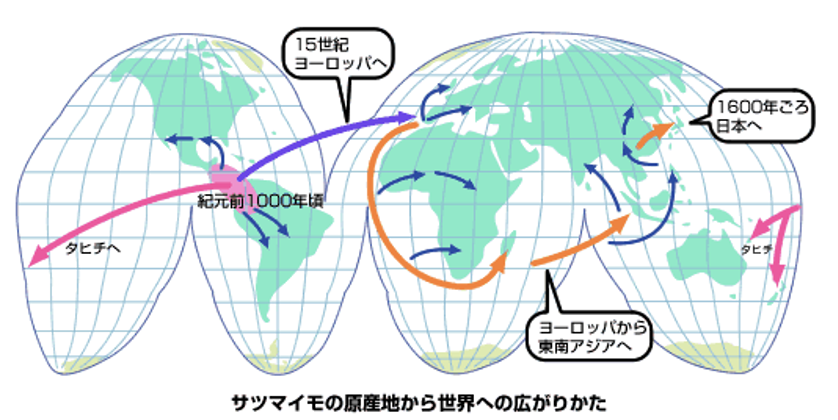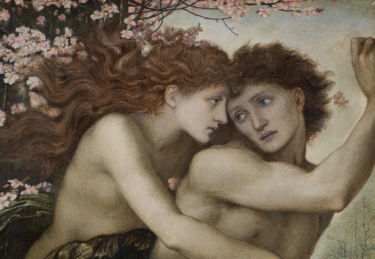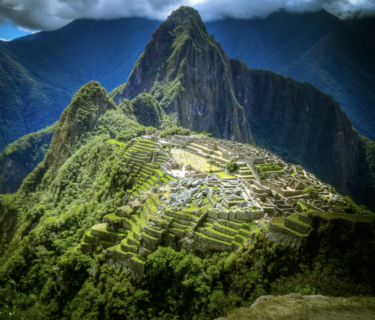はじめに
今日はお芋の観点から歴史を振り返るTED動画を視聴した。以前から、サツマイモとジャガイモの違いやその歴史を振り返ってみたいと思っていたので、これに決めた。興味ある方は是非視聴してみてほしい。
(出典:YouTube)
ポテトの起源
ジャガイモとサツマイモ
ポテト(potato)といえば、ジャガイモだ。ジャガイモはナス科の植物で、南アメリカのアンデス山脈が原産地だ。今では世界中で栽培されていて、デンプンを貯める地下茎が美味しい。一方、さつまいも(sweet potato)も、日本語では同じ芋だし、英語でも同じpotatoだけど、ヒルガオ科の植物で、肥大した根を食する。これも中南米が原産地で世界中で栽培されている。ジャガイモもさつまいももともに、栄養価が高いし、美味しいけど、品種としては大きく異なっていた。

(出典:maff)
ジャガイモの伝搬
ジャガイモの起源を探ると、「イモは7,000年前にペルー南部のチチカカ湖(Lake Titicaca)周辺で最初に栽培された。」と国連サイトに掲載された。ただ、チリは、これに反論していて、オランダの7000種以上のイモはチリ産のジャガイモと遺伝子的な繋がりを持つとチリ起源説を主張している。動画では、8,000年前に南米のアンデス山脈の高地で古代ペルー人が初めてジャガイモを栽培し、インカ帝国を築くための完璧な食糧になったと解説している。インカ帝国は、縄文人と同様に縄算が使われていたことは以前投稿した。なぜ、インカ帝国は標高の高いところに住んだのか、なぜマチュピチュに代表されるほど発展したのかが謎だったけど、その秘密の一つは芋だったのかもしれない。スペイン人は南米で芋を発見し、持ち帰った。大航海時代には野菜不足による壊血病が深刻なリスクとなるが、ジャガイモを食べるとビタミンC欠乏症にはならないことを学んだようだ。一説によると、江戸末期にペリー提督が函館開港を迫ったのは捕鯨船乗組員へのジャガイモと水の補給が目的だと言われている。

(出典:帝国書院)
さつまいもの伝搬
さつまいももメキシコなどの熱帯アメリカで生まれたとされている。紀元前800年から1000年ごろにいは中央アンデス地方でさつまいもが作られ、紀元前200年から600年にはサツマイモをかたどった土器も見つかっている。ヨーロッパに持ち込んだのは15世紀終わりのコロンブスだ。しかし、ヨーロッパではサツマイモにとっては涼し過ぎたため、東南アジアやアフリカの植民地で栽培されて、世界中に広がったとされている。東南アジアには、熱帯アメリカからポリネシアの島々にもっと古い時代に持ち込まれたという説もある。

(出典:maff)
ペルーの多彩なポテト
ポテト発祥の地であるインカの聖なる谷にある公園には、1,367種類のプカサウシライ種というジャガイモがあるという。このクスコにあるポテトパークは、海抜3,400メートルから4,900メートルまでの90平方キロメートルの広大な土地に広がっている。異なる標高で、異なる組み合わせで種をまくことで、ジャガイモの品種改良を古代より進めている。気候変動という課題に対応するための生きた実験場と言える。

(出典:the guardian)
アイルランドのジャガイモ飢饉
動画の中にも出てくるが、ジャガイモには光と影がある。特にアイルランドでは、ジャガイモを栽培し、食料を確保できるようになったことで人口が1740年の300万人から1850年の800万人への倍増した。しかし、1845年から1849年の4年間にわたってヨーロッパ全域でジャガイモの疫病が激発し、アイルランドで栽培されていたアンディジュナ種は壊滅的な被害を受けた。翌年の種芋にすべき芋もなくなり、1940年には人口が400万人に半減した。この飢饉で、アイルランドの人口の10%から20%はアメリカ合衆国やカナダに移住したが、約100万人は餓死を余儀なくされた。しかし、その間にも貴重な食料をアイルランドに供給するのではなく、逆にアイルランドからイングランドに輸出されているなど、人的な側面も見逃せない。新天地のアメリカに移住したアイルランド系はエングランド系に差別を強いられたとも言われている。ヨーロッパの影の部分が見え隠れする。

(出典:ジャガイモ飢饉)
8つの質問
Q1) The ______ civilization was aided by the potato’s nutritional value.
栄養価の高いジャガイモに支えられたのはインカ文明(Incan)だ。
Q2) The potato was too closely related to which deadly species of plant for some European’s comfort?
南米からヨーロッパにジャガイモが持ち込まれた時には、毒性のある、あるナデシコ(Deadly nightshade)に似ているので、敬遠された。
Q3) The Irish potato famine occurred between
アイルランドの大飢饉は1845年から1852に発生したが、人口減少は先に述べたように1940年ごろまで継続して、人口は800万人から400万人に半減した。ジャガイモ飢饉に伴い数百万人のアイルランド系カトリック教徒がカナダに到着し、さらにアメリカ合衆国に移動した。1840年代にはアメリカ国内への移民の半分を占めるまでになったが、イングランド系に差別され、マフィアになったり、警官、消防士、軍人などの危険な仕事に従事するケースが多かったようだ。
Q4) Which country brought the potato to Europe?
ポテトをヨーロッパに持ち込んだのはスペイン人だ。
Q5) How many Irish starved to death during the Irish potato famine?
アイルランドでの飢饉では百万人が飢餓で死んだと言われている。今ならSNSで訴えて、世界中へ食料提供を求め、世界中から食料が寄せ集まったのではと思う。忘れてはいけない悲しい出来事だ。
Q6) How did the potato help bring about the Industrial Revolution?
この質問は、じゃがいもが産業革命にどのように貢献したのかという内容だ。じゃがいもは、この当時は、特に産業革命を支える労働者階級の人たちの重要な栄養源となっていたので、次のような感じだろうか。
Q7) What other reasons could the Europeans have had for not wanting to eat potatoes at first?
これはQ2とも類似しているが、最初にジャガイモがヨーロッパに持ち込まれた時には、このジャガイモが毒性のベラドンナに似ているので、食べるのを敬遠したので、次のような感じだろうか。
Q8) What were the main countries to which the Irish migrants fled?
アイルランド飢饉の時に、アイルランドの国民が新天地として向かったのはカナダであり、アメリカ合衆国だ。しかし、その新天地アメリカでも、イギリス系移民がアイルランド系移民を差別するという悲しい構図があったことは先にも述べた。英語では次のような感じだろうか。
まとめ
ジャガイモの歴史を紐解くと、インカ帝国の神秘の話に気になった。その後、コロンブスなどの探検家がヨーロッパに持ち帰ったジャガイモが当初は食用としては見向きもされなかったけど、アイルランドで栽培されるようになり、アイルランドの人口が倍増した。しかし、その後の疫病の弊害からアイルランドの人口が半減するほどの飢饉と飢餓が起きた。これを逃れるために多くのアイルランド人がアメリカ合衆国に渡った。ジョンFケネディもレーガンも、クレイントンもアイルランド系だ。アメリカンドリームを夢見て、それを勝ち取ったのをアイルランドの祖先の人は目を細めてみているのではないだろうか。
以上
最後まで読んで頂きありがとうございます。
拝
参考:英文スクリプト
Let’s Begin…
Baked or fried, boiled or roasted, as chips or fries. At some point in your life, you have probably eaten a potato. Delicious, for sure, but the fact is potatoes have played a much more significant role in our history than just that of the dietary staple we have come to know and love today. Without the potato, our modern civilization might not exist at all.
8,000 years ago in South America, high atop the Andes, ancient Peruvians were the first to cultivate the potato. Containing high levels of proteins and carbohydrates, as well as essential fats, vitamins, and minerals, potatoes were the perfect food source to fuel a large Incan working class as they built and farmed their terraced fields, mined the Rocky Mountains, and created the sophisticated civilization of the great Incan Empire.
But considering how vital they were to the Incan people when Spanish sailors returning from the Andes first brought potatoes to Europe, the spuds(ジャガイモ) were duds(不発弾). Europeans simply didn’t want to eat what they considered dull and tasteless oddities from a strange new land, too closely related to the deadly nightshade plant belladonna for comfort.
So instead of consuming them, they used potatoes as decorative garden plants. More than 200 years would pass before the potato caught on as a major food source throughout Europe, though even then, it was predominantly eaten by the lower classes.
However, beginning around 1750, and thanks at least in part to the wide availability of inexpensive and nutritious potatoes, European peasants with greater food security no longer found themselves at the mercy of the regularly occurring grain famines(飢餓) of the time, and so their populations steadily grew.
As a result, the British, Dutch, and German Empires rose on the backs of the growing groups of farmers, laborers, and soldiers, thus lifting the West to its place of world dominion. However, not all European countries sprouted empires.
After the Irish adopted the potato, their population dramatically increased, as did their dependence on the tuber as a major food staple(主食). But then disaster struck.
From 1845 to 1852, potato blight disease ravaged the majority of Ireland’s potato crop, leading to the Irish Potato Famine, one of the deadliest famines in world history. Over a million Irish citizens starved to death, and w million more left their homes behind.
But of course, this wasn’t the end for the potato. The crop eventually recovered, and Europe’s population, especially the working classes, continued to increase.
Aided by the influx of Irish migrants, Europe now had a large, sustainable, and well-fed population who were capable of manning the emerging factories that would bring about our modern world via the Industrial Revolution.
So it’s almost impossible to imagine a world without the potato. Would the Industrial Revolution ever have happened? Would World War II have been lost by the Allies without this easy-to-grow crop that fed the Allied troops?
Would it even have started? When you think about it like this, many major milestones in world history can all be at least partially attributed to the simple spud from the Peruvian hilltops.




